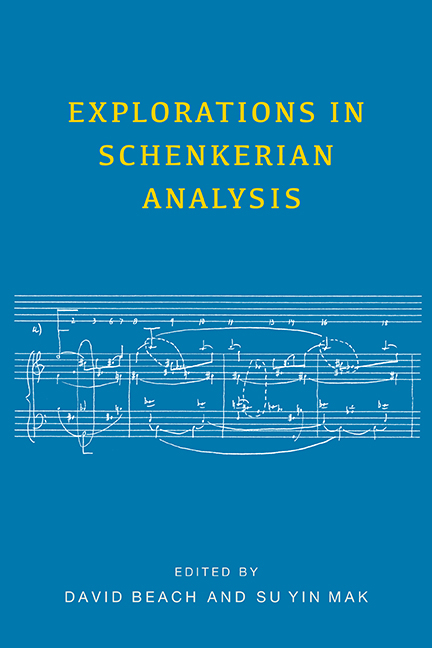Book contents
- Frontmatter
- Contents
- Preface
- Part One Eighteenth Century
- Part Two Early Nineteenth Century
- Part Three Late Nineteenth Century
- 11 Half-Diminished-Seventh Openings in Brahms's Lieder
- 12 Motivic Enlargement in Dvořák's Symphony Op. 70
- 13 Deliverance and Compositional Design in the “Libera me” of Verdi's Messa da Requiem
- 14 Polyphony and Cacophony? A Schenkerian Reading of Strauss's “Dance of the Seven Veils”
- 15 A Force of Nature: Debussy and the Chromatically Displaced Dominant
- Appendix: An Interview with Edward Laufer
- List of Contributors
- Index
11 - Half-Diminished-Seventh Openings in Brahms's Lieder
from Part Three - Late Nineteenth Century
Published online by Cambridge University Press: 28 June 2018
- Frontmatter
- Contents
- Preface
- Part One Eighteenth Century
- Part Two Early Nineteenth Century
- Part Three Late Nineteenth Century
- 11 Half-Diminished-Seventh Openings in Brahms's Lieder
- 12 Motivic Enlargement in Dvořák's Symphony Op. 70
- 13 Deliverance and Compositional Design in the “Libera me” of Verdi's Messa da Requiem
- 14 Polyphony and Cacophony? A Schenkerian Reading of Strauss's “Dance of the Seven Veils”
- 15 A Force of Nature: Debussy and the Chromatically Displaced Dominant
- Appendix: An Interview with Edward Laufer
- List of Contributors
- Index
Summary
The half-diminished seventh chord appears frequently in Brahms's works and in various roles, perhaps none more poetic than as a modally mixed plagal elaboration of a tonic harmony in a major key. In some pieces, such as the Capriccio, op. 116, no. 1, the sonority provides the main motivic seed, a feature facilitated by Brahms's penchant for congruence of melodic and harmonic content, in Edward T. Cone's terminology. In other works, Brahms embeds the half-diminished seventh chord in a more abstract network of relationships. Peter H. Smith has studied the connection between the half-diminished seventh's harmonic function and metrical setting in the opening movement of the Clarinet Trio, op. 114, revealing a correlation between its function as plagal embellishment and metrical consonance on the one hand, and its function as dominant preparation and metrical displacement on the other. Despite Brahms's fondness for the half-diminished seventh, rarely does one of his works begin with this chord. This essay focuses on three lieder that do, although—as we will see—even among these three lieder, viewing a half-diminished sonority as the music's starting point is sometimes accurate only in partial ways.
The three lieder in question are: “Nachtigallen schwingen” (op. 6, no. 6), “Die Liebende schreibt” (op. 47, no. 5), and “Die Schale der Vergessenheit” (op. 46, no. 3). “Die Liebende schreibt” was composed around 1858, a decade earlier than its opus number would suggest. The chronological order of their composition happens to match the increasing complexity of large-scale tonal structure across these three songs. In each case, the half-diminished seventh is readily interpreted as an event belonging only to the foreground, but in each case the striking launch is not without larger impact. Each lied revisits its opening half-diminished seventh and later gives special roles to the sonority's outer-voice pitches. In “Nachtigallen schwingen,” the tonic Stufe arrives solidly at the end of the opening strophe, whereas in the later songs the half-diminished seventh resolves to a first-inversion tonic chord, and an auxiliary cadence serves as tonal background.
- Type
- Chapter
- Information
- Explorations in Schenkerian Analysis , pp. 201 - 225Publisher: Boydell & BrewerPrint publication year: 2016
- 1
- Cited by

